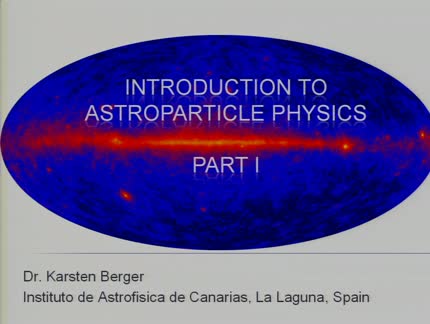Found 18 talks width keyword particle physics

Abstract
Rutherford discovered the atomic nucleus in 1912 in an experiment on a table top. The LHC will be producing its first major results by 2012, involving teams of thousands and apparatus that is bigger than Rutherford's entire laboratory. How did science come to this, and what are the questions the LHC hopes to answer? What is Higgs' boson, and is it really Higgs that invented it? I will explore the role of symmetry and asymmetry in physics, and illustrate how the ideas that have been associated with Higgs' name have a long history.
Abstract
This seminar talk will give a short overview of the current status of the field of Astroparticle Physics. The subject includes a great variety of instruments working in different energy ranges (from a few MeV to 1020 eV) and studying different particles (neutrinos, protons, gamma-rays and more). Finally, a short discussion regarding the connection between the observations and the physics at the Large Hadron Collider will be discussed.
Abstract
The Atacama Cosmology Telescope (ACT) has been observing the southern sky in the millimeter range with an angular resolution at the arc-minute level. An analysis of 228 square degrees observed at 148 GHz along a stripe centered at declination -53 degrees reveals the presence of the Silk damping tail in the temperature angular power spectrum of the Cosmic Microwave Background (CMB). This decaying tail becomes truncated by a rising spectrum at scales corresponding to few arcmins (l ~ 3000) whose origin is compatible with a unclustered population of unresolved point sources and some residual anisotropy due to Compton scattering of CMB photons off free electrons (the Sunyaev-Zel'dovich effect). Comparisons with other observations and constraints on different components giving rise to this secondary spectrum are discussed.
Abstract
History: astroparticle physics emerged from particle physics and connects it to astrophysics. Early particle physics was based on cosmic ray studies. The 1930s and 1940s were dominated by the discovery of new particles (positron, muon, pion) and the problems of their identification. In the 1950s, the era of the big accelerators began. Recent astroparticle physics started in the 1980s, with solar neutrino measurements and the investigation of cosmic rays by means of particle detectors.

Abstract
New results on the antiproton-to-proton and positron-to-all electron ratios over a wide energy range (1 – 100 GeV) have been obtained by the PAMELA mission. These data are mainly interpreted in terms of dark matter annihilation or pulsar contribution. The instrument PAMELA, in orbit since June 15th, 2006 on board the Russian satellite Resurs DK1, is daily delivering to ground 16 Gigabytes of data. The apparatus is designed to study charged particles in the cosmic radiation, with a particular focus on antiparticles for searching antimatter and signals of dark matter annihilation. A combination of a magnetic spectrometer and different detectors allows antiparticles to be reliably identified from a large background of other charged particles. The talk will illustrate the most important scientific results obtained by PAMELA, together with some of the more recent theoretical interpretations.

Abstract
Las clases se impartirán en el aula los días 4, 5 y 6 de noviembre de 2008 en horario de 10:30 a 12:30 Programa del curso: 1.- Introduction 2.- Electromagnetic Interaction (QED) 3.- Strong Interaction (QCD) 4.- Electroweak Interaction 5.- Precision Tests 6.- CP Violation and B Physics 7.- Neutrino Masses 8.- Beyond the Standard Model 9.- Physics at LHC

Abstract
Programa del curso: 1.- Introduction 2.- Electromagnetic Interaction (QED) 3.- Strong Interaction (QCD) 4.- Electroweak Interaction 5.- Precision Tests 6.- CP Violation and B Physics 7.- Neutrino Masses 8.- Beyond the Standard Model 9.- Physics at LHC

Abstract
Programa del curso: 1.- Introduction 2.- Electromagnetic Interaction (QED) 3.- Strong Interaction (QCD) 4.- Electroweak Interaction 5.- Precision Tests 6.- CP Violation and B Physics 7.- Neutrino Masses 8.- Beyond the Standard Model 9.- Physics at LHC
<< First « Newer 1 | 2 Older »
Upcoming talks
- TODAY: EMO-1: Construyendo un observatorio caseroEnol Matilla BlancoFriday April 19, 2024 - 10:30 GMT+1 (Aula)
- Classical Be stars - Constraining binary interaction physics in massive starsDr. Julia BodensteinerThursday April 25, 2024 - 10:30 GMT+1 (Aula)








